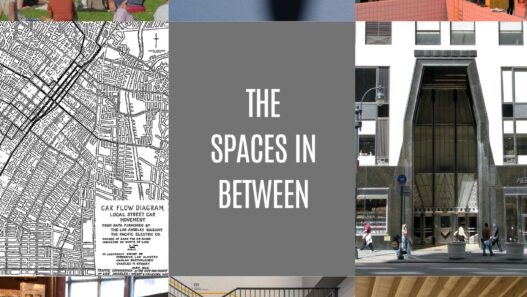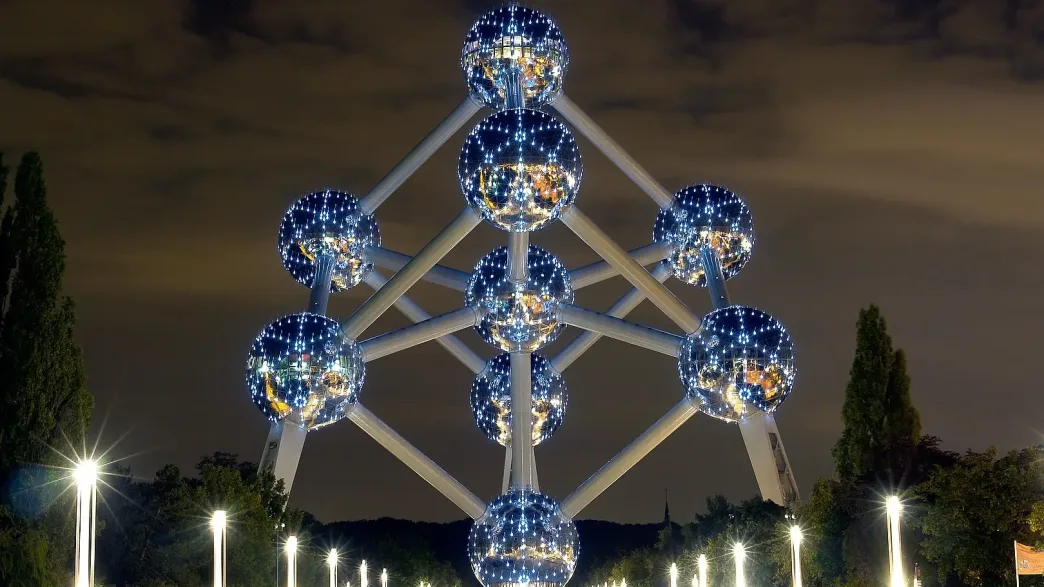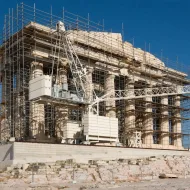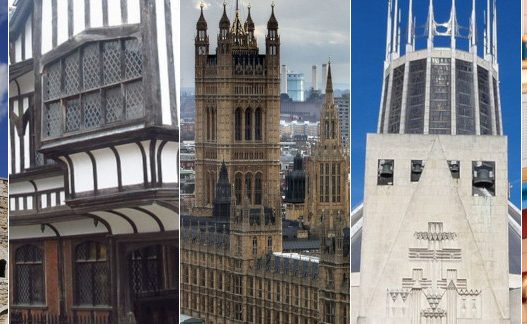Imagine a time when the world was abuzz with excitement about the future; a time when sleek lines, bold shapes and a sense of cosmic wonder shaped the buildings and homes people lived in. This is the essence of Atomic Age architecture and design, a mid-century movement that captured the spirit of the 1950s and early 1960s. It was a time when humanity seemed on the verge of something extraordinary, and architects and designers channeled that energy into structures that looked like they belonged in a science fiction movie. From quirky roadside diners to futuristic houses with pitched roofs, Atomic Age design was not about buildings – it was about dreaming big.
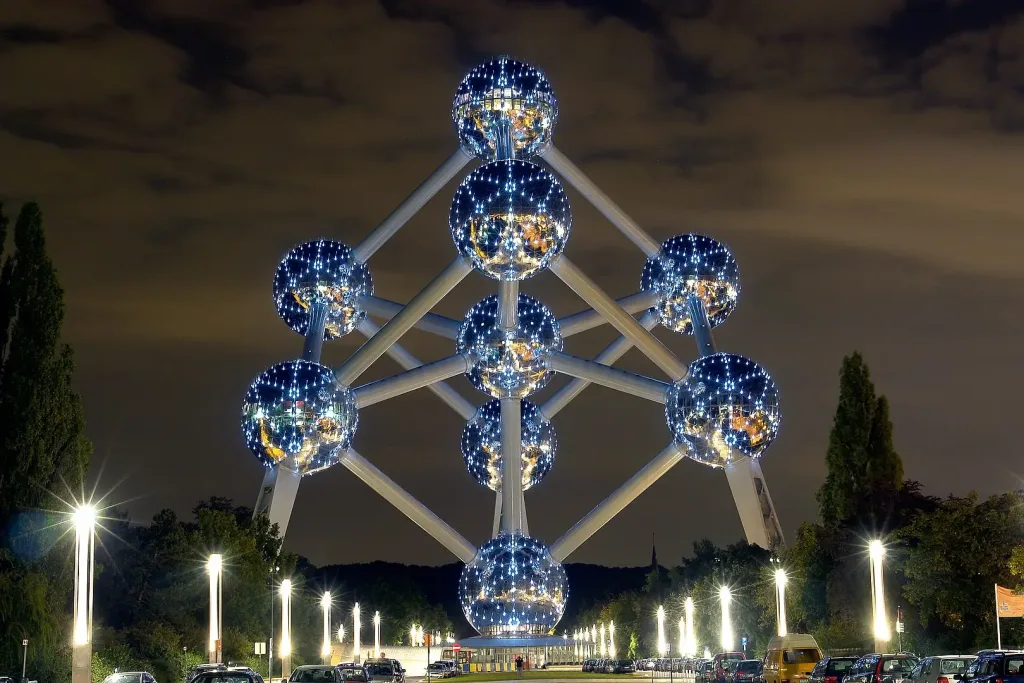
Origins of Atomic Age Architecture
The story of Atomic Age architecture begins in a world ready for a new beginning. After the hardships of the Second World War, people were eager to embrace a new era full of hope, innovation and a dash of fun. It was about creating spaces that reflected the wild possibilities of tomorrow. Inspired by the rapid changes happening around them, the architects blended technology, science and a touch of the cosmic. The result was a style that felt like a bridge between the everyday and the extraordinary, with buildings that seemed to hum with the energy of a world in motion.
Post-War Optimism and Technological Advances
Imagine the late 1940s and early 1950s: the war was over and people were ready to leave the past behind. After a collective sense of relief, there was an explosion of enthusiasm for what could come next. This optimism fueled Atomic Age architecture, where designers sought new materials and methods to redefine how people lived. Steel, glass and concrete became the stars of the show thanks to wartime innovations that made them cheaper and easier to use. Houses began to have large windows that let in floods of light, while furniture took on smooth, curvy shapes that felt almost alive. Take the classic Eames chair, for example; its molded plywood and playful design screamed modernity. This was a time when technology was a symbol of hope, and architects used it to create spaces that felt like a celebration of human creativity.
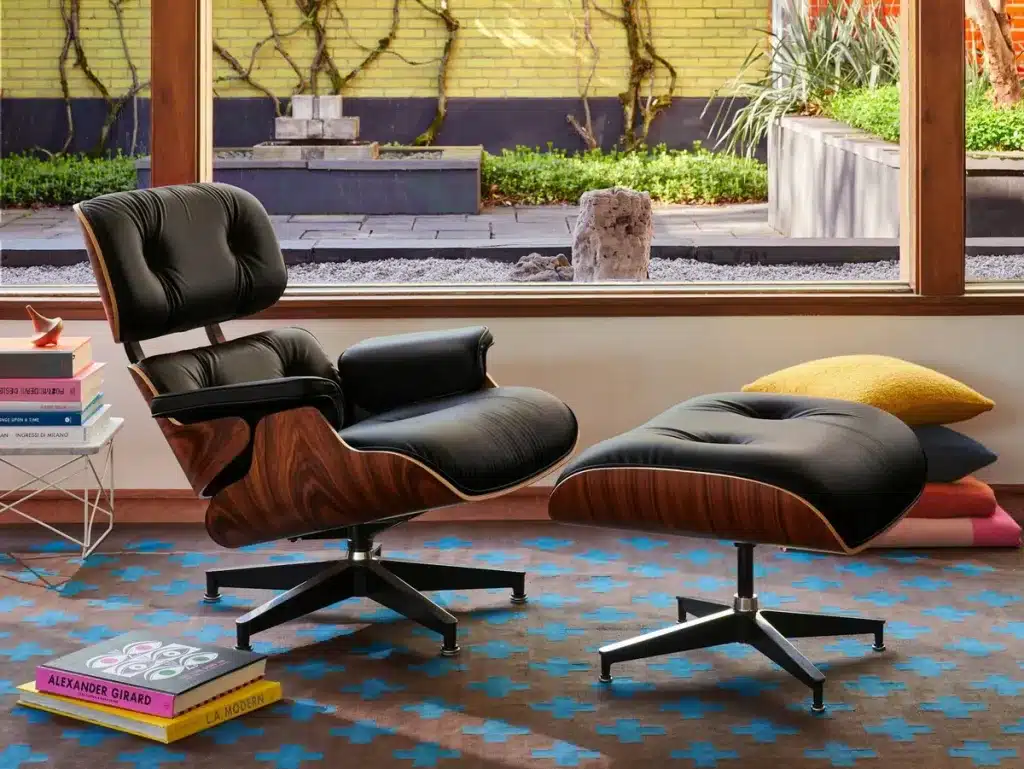
Impact of the Space Race
Now let’s turn our gaze towards the stars. The Space Race began in the 1950s when the United States and the Soviet Union competed to conquer the universe. Suddenly the idea of rockets, satellites and life beyond Earth was on everyone’s mind, and architects couldn’t resist the pull. Features reflecting this fascination began to sprout in Atomic Age buildings: think curved rooflines that mimic the curve of a spaceship, or starburst patterns that shimmer like a galaxy. The Theme Building at Los Angeles International Airport is a perfect image of this mood, with its flying saucer-like structure perched on delicate stilts. Even everyday places like coffee shops and motels got into the game, with neon signs and futuristic fonts that make you feel like you’re stepping into a sci-fi adventure.
Impact of Nuclear Energy Developments
The atomic bomb changed the world in 1945, and its effects were not limited to devastation, but inspired a strange awe. By the 1950s, nuclear energy was hailed as the power of tomorrow, promising endless possibilities. This duality – fear and fascination – was reflected in Atomic Age design. Architects played with atom-inspired shapes such as boomerang angles and circular motifs in a nod to the era’s scientific obsession. The idea of harnessing something so powerful influenced bold, experimental structures that felt almost otherworldly. Look at Buckminster Fuller’s Geodesic Dome: its net-like skeleton was a symbol of a world rethinking what was possible. Nuclear power was a cultural spark that lit the imagination of designers everywhere.
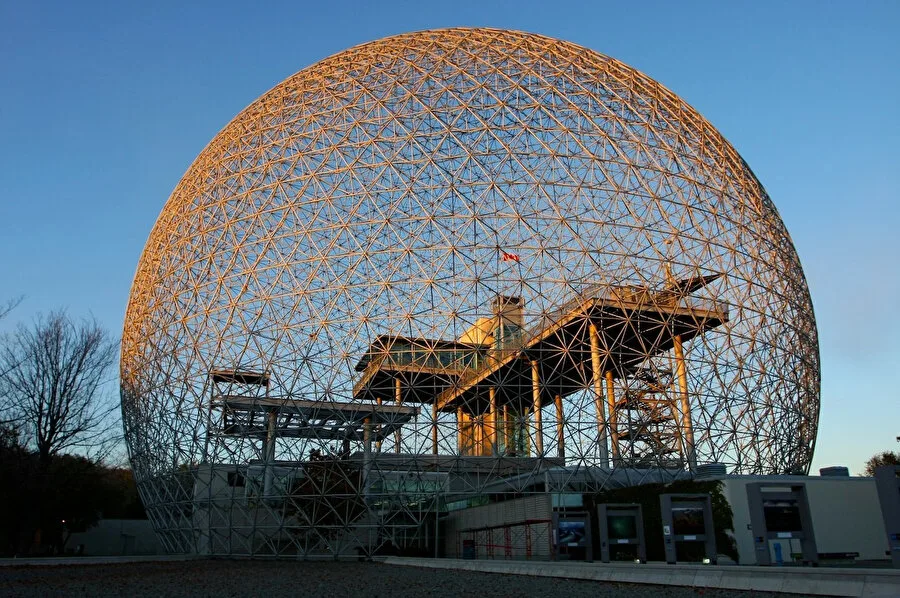
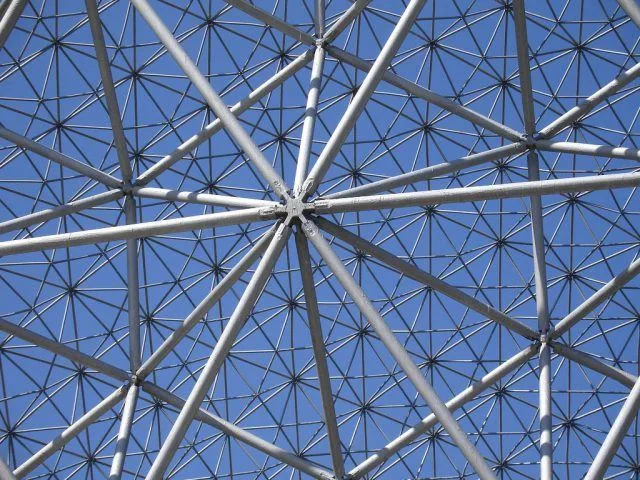
Evolution from Mid-Century Modernism
Atomic Age architecture didn’t come out of nowhere; it was born out of the roots of Mid-Century Modernism, a style that was already a disruptive style. Mid-Century Modernism loved clean lines, open spaces and a connection to nature, but the Atomic Age took these ideas and hurled them into orbit. Where Mid-Century Modern homes might have had a flat roof and a cozy porch, Atomic Age designs upped the drama with oblique angles, pops of color and a futuristic edge.
Important Pioneers and Visionaries
Behind every great movement are people who dare to think differently, and the architecture of the Atomic Age had its share of these pioneers. Eero Saarinen, with his knack for sculptural forms, gave us the Gateway Arch in St. Louis – a soaring symbol of progress that feels both timeless and futuristic. Then there’s John Lautner, whose Chemosphere House in Los Angeles looks like a UFO perched on a hillside, blending wild imagination with practical living. These visionaries were not afraid to push boundaries, using new materials and bold ideas to create spaces that still fascinate us. Even Walt Disney got in on the fun by building the House of the Future at Disneyland in 1957; this plastic marvel showed how Atomic Age design could transform everyday life. These pioneers built a vision of a world where anything seemed possible.
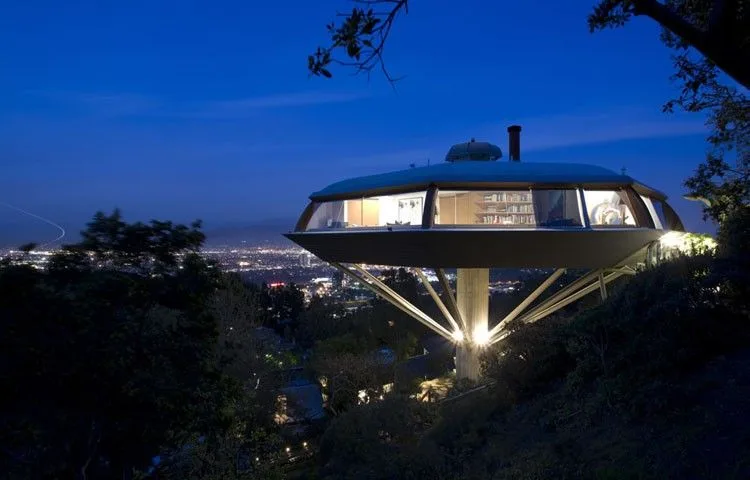
Defining Characteristics of the Style
Atomic Age architecture and design burst onto the scene with a distinctive personality, a dazzling blend of optimism and imagination that you could spot from a mile away. This style was not about playing it safe; it was loud, proud and ready to take you on a journey into the future. Imagine houses and buildings that seemed to dance with sharp angles, shimmering surfaces and a cosmic allure. These were expressions of a world full of possibilities. Let’s peel back the layers that make this style so memorable, from its eye-catching shapes to its vibrant spirit.
Bold Geometric Shapes and Angles
Step into the Atomic Age and you’ll immediately notice one thing: This style likes to play with geometry in the most daring ways. Forget boring boxes; buildings have taken on sharp, sloping roofs that seem to defy gravity, or curved walls that flow like waves. It was as if the architects grabbed a ruler and a protractor and decided to have some fun. Think of Googie-style coffee shops like Norms in Los Angeles, with its jagged, boomerang-shaped roofs that look ready to be launched into the sky. These bold shapes captured the restless energy of the era, a time when people wanted to feel as dynamic as the changes happening around them. Every aspect told a story of movement, progress and a bit of rebellion against the ordinary.
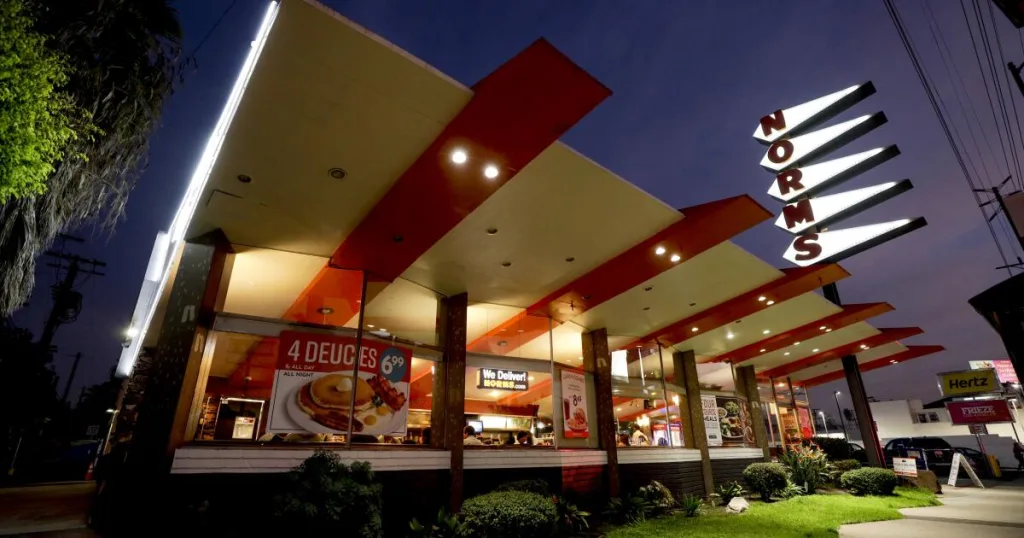
Futuristic Materials and Textures
The Atomic Age was not afraid to show off the latest and greatest in building technology. Architects reached for materials that felt like they belonged on a spaceship; gleaming steel, smooth plastic and shimmering aluminum were the heroes of the day. They were a flexibility, a way of saying, “Look how far we have come!” Textures became playful too, with rough concrete walls sitting alongside glossy surfaces that caught the light just right. The Monsanto House of the Future at Disneyland, made almost entirely of fiberglass, was a jaw-dropping example – its sleek, molded forms felt like a glimpse into life on another planet. These futuristic finishes have built a mood that whispers the promise of a bright, high-tech tomorrow.
Iconic Starburst and Atomic Motifs
If there’s one thing that screams Atomic Age, it’s dazzling starburst patterns and atom-inspired details. Imagine a burst of lines radiating like a firework frozen in time, or tiny orbiting dots mimicking the dance of electrons. These motifs were ubiquitous on watches, wallpaper, even on the facades of buildings. They were a nod to the era’s fascination with science and space, and a way of injecting a little cosmic magic into everyday life. The Satellite Motel signs with their glowing neon starbursts or the Sputnik chandelier with its spiky, orbiting arms are perfect examples; simple yet striking, they transform ordinary objects into symbols of wonder. These designs were a celebration of a world spinning towards the stars.
Large Glass and Open Spaces
Large windows and airy interiors were at the heart of Atomic Age design, letting the outside world in and making spaces feel limitless. By replacing heavy walls with sheets of glass, the architects created homes that blurred the line between inside and outside. It was about freedom, about letting light and sky be part of the living experience. Imagine a ranch-style home with floor-to-ceiling windows, where you can sip your coffee and feel like you’re floating in the landscape. The Stahl House in Los Angeles, perched on a cliff with its walls of glass framing the city below, captures this perfectly – more a view of the universe than a house. This openness was a philosophy, a way of embracing the vastness of the future.
Vibrant Color Palettes
Atomic Age design didn’t whisper, it shouted and its colors were megaphones. Gone were the muted hues of the past; in came electric blues, fiery oranges and sunny yellows that popped like comic book pages. These were not random choices; the bright hues reflect the cheerful mood of the era, bringing joy to a world ready to move forward. Indoors, a lime green sofa was paired with a turquoise wall, while pastel pinks or deep reds were used outdoors. The Flamingo Hotel in Las Vegas, with its neon glow, shows how color can transform a building into an entertainment hub. These vibrant palettes were a burst of energy, a way of painting the future in hues that matched his wild ambition.
Iconic Examples of Atomic Age Buildings
The Atomic Age was a revolution that left behind some of the most jaw-dropping buildings ever imagined. These structures didn’t blend into the background; they stood out like beacons of a future within reach. From airports that looked like they could fly to houses perched on hillsides like spaceships, Atomic Age architecture turned imagination into concrete, steel and glass. Each building tells the story of an era when the world was obsessed with progress, space and the thrill of the unknown. Let’s take a walk through some of the most iconic examples where bold ideas meet real-world magic.
Theme Building at LAX
Imagine yourself landing at Los Angeles International Airport in the 1960s and the first thing you see is a structure that looks like it is about to explode. This is the Theme Building, one of the masterpieces of the Atomic Age, opened in 1961. Designed by architects William Pereira and Charles Luckman, the building is a flying saucer balancing on slender, curved legs that give it a weightless, futuristic air. Surrounded by neon, the circular observation deck glows like a halo at night, while the curving rooflines reflect the jet age it was built to celebrate. It was a welcome mat for a city that grew up with dreams. Today it is a beloved landmark, a reminder of a time when travel felt like a ticket to the stars.
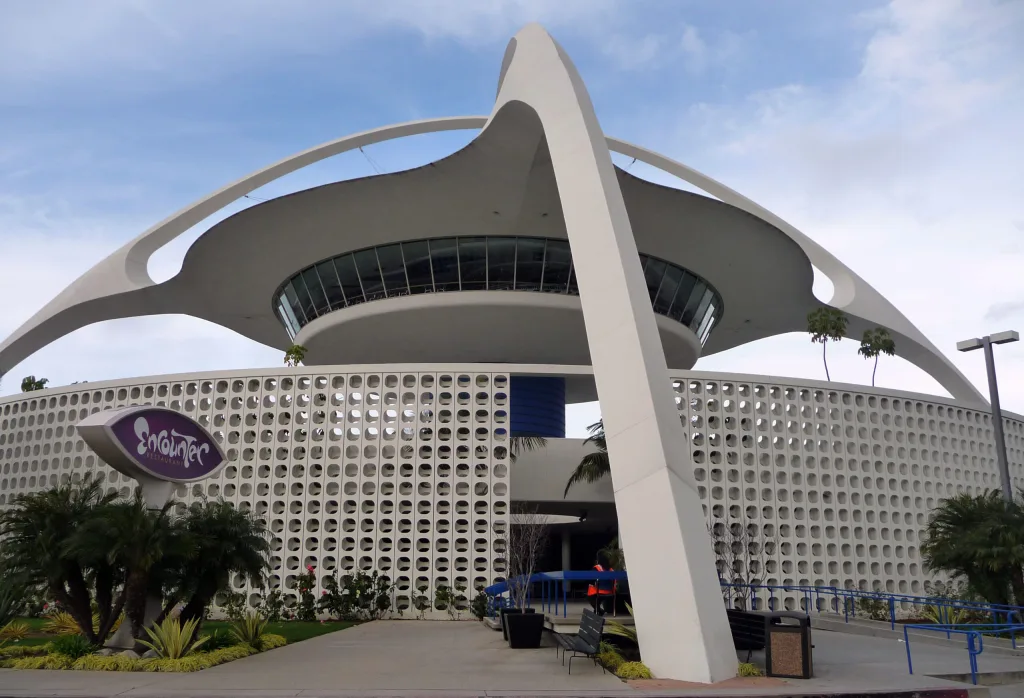
Buckminster Fuller’s Geodesic Domes
Buckminster Fuller didn’t just design buildings, he reimagined what they could be, and his Geodesic Domes are the most brilliant proof of that. These lightweight, spherical marvels of interlocking triangles look like something out of a science fiction novel. Fuller’s big idea was efficiency: the shape of the dome uses less material to cover more space, making it strong and surprisingly simple. The most famous of these may be the Expo ’67 Biosphère in Montreal; a huge, glittering sphere that feels like a planet in its own right. Built in 1967, the dome’s net-like frame reflected the Atomic Age spirit of innovation and exploration. These domes were a bold statement in solving problems with creativity and have inspired everything from greenhouses to modern eco-houses.
Kemosphere House
Rising like a UFO on stilts above the Hollywood Hills, the Chemosphere House is Atomic Age architecture at its craziest. Designed by John Lautner in 1960, this octagonal marvel sits on a single concrete column, giving it the appearance of a spaceship ready to take off. The story behind it is just as fascinating: built on a steep, unbuildable lot for a young engineer, Lautner turned a challenge into a triumph. The glass walls that wrap around the house offer panoramic views of Los Angeles that make you feel like you’re floating in mid-air. Inside, the space-age vibe continues with sleek finishes and a layout that is both cozy and cosmic. Not just sitting on the earth, but seemingly defying it, this house is a perfect snapshot of the era’s fearless imagination.
Seattle’s Space Needle
As the 1962 Seattle World’s Fair approached, the city needed a spectacle and the Space Needle delivered. Designed by John Graham and inspired by the Space Race, this tower rose 605 meters into the sky, becoming an instant icon. Its slender tripod base expands to a broad, saucer-like top, complete with an observation deck that promises a view of tomorrow. The needle’s futuristic silhouette, painted in dark “Astronaut White” and “Galaxy Gold”, reflected the Atomic Age’s obsession with all things celestial. It symbolized a world reaching for the stars. Even today, it stands as a reminder of a time when humanity looked up and dreamed beyond.

Tomorrowland at Disneyland
Walt Disney also built a vision of the future, and Tomorrowland was at the heart of that vision. When it first debuted in 1955, this corner of Disneyland was a playground of Atomic Age optimism, filled with sleek structures and space-age marvels. The original design featured rocket-shaped rides and a gleaming white palette that evoked a trip to a lunar colony. Over the years, landmarks such as the TWA Moonliner, designed with the help of aerospace engineers, have given visitors a taste of the cosmos. Tomorrowland was a love letter to a world obsessed with progress, where every curve and color whispered the promise of adventure. It has evolved since then, but its roots still shine brightly and are a testament to the boundless hope of the era.
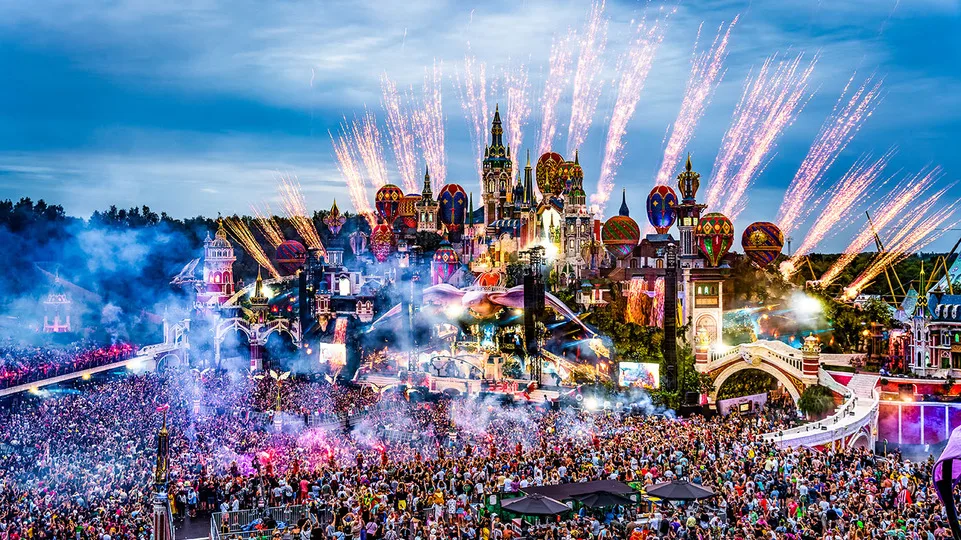
Interior Design in the Atomic Era
Step into an Atomic Age home and you step into a vision of the future seen through the eyes of the 1950s and early 1960s. This was a time when interiors told a story of optimism, innovation and a playful leap into the unknown. Furniture curved in convention-defying shapes, walls glowed with a futuristic flair and even the lighting seemed to hum with possibilities. Atomic Age interior design was about much more than decoration; it was about creating a mood to match the era’s wild dreams of space travel and technological wonders. From quirky chairs to glowing lamps, let’s discover what makes these spaces unforgettable.
Space Age Furniture Innovations
In the Atomic Age, furniture didn’t stand still, it danced. Designers threw out the rulebook and embraced shapes that looked like they belonged on a spaceship. Chairs and tables took on smooth, curved lines, often molded from new materials like plastic and fiberglass. The Eames Lounge Chair, with its sleek plywood curves and cozy leather, became a star of the time – comfortable but state-of-the-art, it felt like a seat for a modern astronaut. Then there were pieces like Eero Saarinen’s Tulip Chair, perched on a single, slender stem like a flower from the future. These innovations showed what technology could do, transforming everyday objects into symbols of a brave new world. Homes became galleries of these sculptural jewels, each one a conversation starter.

Retro-Futuristic Decor Elements
The Atomic Age would have loved a good dose of retro-futuristic glamor – think decor that blinks nostalgia into tomorrow. Walls could have wallpapers featuring orbiting planets or atomic starbursts, tiny bursts of energy that transform a room into a cosmic playground. Clocks and mirrors often had iconic pointed shapes, like the little brother of the Sputnik chandelier, adding a sci-fi sparkle. Houseplants also joined in the fun, placed in angled ceramic pots that matched the era’s love of asymmetry. It was a style that felt both familiar and distant, like a 1950s sitcom set on Mars. These elements transported you into your home and made every corner of the house feel like a snapshot of a dreamy future.
Integration of Technology into Living Spaces
In the Atomic Age, technology was not hidden but celebrated, woven into the fabric of everyday life. Kitchens gleamed with shiny chrome appliances like electric stoves and toasters that looked ready to launch breakfast into orbit. Living rooms had hi-fi stereos with wooden cabinets, their glowing dials promising crystal-clear sound from the future. Some homes even had built-in televisions framed like windows into another world, a nod to the era’s obsession with media and connectivity. The Monsanto House of the Future at Disneyland took it even further with push-button controls for lights and curtains – pure magic for mid-century eyes. It was about showing how technology can make life smoother, more stylish and a little more exciting.
Boomerang Patterns and Asymmetry
Instead of symmetry, he embraced boomerang patterns and unusual designs that make your eyes move. Imagine a coffee table shaped like a kidney bean or a zigzag rug bouncing across the floor. These boomerang curves – sharp but playful – appeared in everything from Formica countertops to cushions, reflecting the era’s love of movement and energy. Asymmetry ruled the day, with furniture arranged in unexpected ways and murals hung at interesting angles. It was a rebellion against the rigid, balanced rooms of the past, a way of reflecting the unpredictable, fast-paced world outside. Every twist and turn was a nod to the atomic forces that shaped the age – dynamic, bold and a little wild.
Lighting Design and Ambience
In the Atomic Age, lighting set the tone for a whole new way of life. Lamps became sculptures, like the Arco Floor Lamp with its giant, curved arm that seemed to radiate light from outer space. Sputnik chandeliers with exploding star arms hung from the ceiling, casting a warm, futuristic glow. Even simpler designs, such as tripod table lamps with tapered shades, added a touch of drama to quiet corners. Ambience was crucial: soft, diffused light mixed with neon or bursts of color to create spaces that felt both cozy and exciting. It was lighting that invited you to dream, transforming the living room into a stage for mid-century magic.
Cultural Influence and Heritage
The Atomic Age left its mark on the way people thought, imagined and saw the world. Born in the glow of the 1950s and early 1960s, it was more than a design trend; it was a cultural wave that spread to movies, music and even the way we imagine the future. Its wild shapes and starry-eyed optimism captured a moment when humanity felt ready for greatness, and that energy still resonates today. Whether it inspires a retro diner or sparks preservation debates, the legacy of Atomic Age architecture and design is a living part of our story. Let’s explore how it has changed culture, how we keep it alive and why it still matters.
Popular Culture and its Impact on the Media
The Atomic Age was not confined to blueprints; it spilled onto screens and songs, coloring the popular culture of its time and beyond. Think of the 1960s cartoon Jetsons, where flying cars and robot servants lived in houses with sloping roofs and starry decor – the pure sensations of the Atomic Age brought to life. Movies like Forbidden Planet leaned into the era’s sci-fi obsession, with sleek sets reflecting the futuristic vibe of the style. Even the music was supported by album covers featuring boomerang shapes and neon hues. Today this influence continues in movies like Back to the Future or television shows like Mad Men, where the mid-century vibe gets a nostalgic nod. It was a mentality that turned everyday life into a space-age adventure.
Efforts to Preserve Atomic Age Structures
As time marches on, these quirky diners and spaceship-like homes face the wrecking ball, but a passionate team of fans is fighting to save them. Preservationists see these buildings as more than just old ruins – they are snapshots of a hopeful era worth holding on to. Groups like the National Trust for Historic Preservation have supported efforts to preserve landmarks like the Theme Building at LAX or the Googie-style cafes in Los Angeles. It’s not always easy – some argue that these structures are outdated or too costly to maintain – but the backlash can be fierce. Take the restoration of the Chemosphere House: This once dilapidated structure is now a shining example of how love and manual labor can keep the Atomic Age alive. These efforts are about letting a piece of history breathe.
Revival of Modern Design Trends
The Atomic Age is not a thing of the past; it’s making a comeback in today’s homes and spaces. Designers are dusting off those bold shapes and bright colors and blending them with modern touches to create spaces that feel both retro and fresh. You might see a starburst clock on a minimalist wall or a boomerang-patterned rug in a chic loft. Mid-century-inspired furniture like Eames chair replicas are everywhere, proving that the style of the era still has legs. Hip cafes and boutique hotels are also embracing the vibe, with neon signs and angled roofs winking back to the 1950s. It’s a yearning for that playful, optimistic energy in a world that sometimes feels too serious. The Atomic Age proves timeless, one funky lamp at a time.
Criticisms and Controversies
Not everyone is a fan of the flamboyant legacy of the Atomic Age. Some critics at the time called it pretentious – too loud, too garish, a passing fad that didn’t deserve serious attention. The obsession with nuclear themes also raised eyebrows; linking home decoration to something as dark as an atomic bomb seemed unsettling to some, even if it was considered a hopeful turn. Today, the preservation debate swirls: should we pour money into saving a kitsch motel when housing needs are urgent? Others see the style as a symbol of a naive era and ignore the Cold War fears that lie beneath the surface. These criticisms don’t take away from its appeal, but they add layers to the story – a reminder that even the brightest designs have shadows.
The Enduring Symbolism of Optimism
At its core, the Atomic Age was about looking up, not down. Its sloping roofs and starry motifs were a cry of faith in a better tomorrow. Born in a post-war world hungry for hope, this optimism still resonates. When you see the Space Needle piercing the sky or a Googie diner glowing on the highway, you get the feeling that anything is possible. That’s why this style endures even when trends change; it’s a tonic for cynicism, a reminder that people can dream big even in difficult times. The Atomic Age wasn’t perfect, but the spirit of curiosity and invention keeps it alive and inspires us to imagine the next step with a little more sparkle in our step.
Discover more from Dök Architecture
Subscribe to get the latest posts sent to your email.



